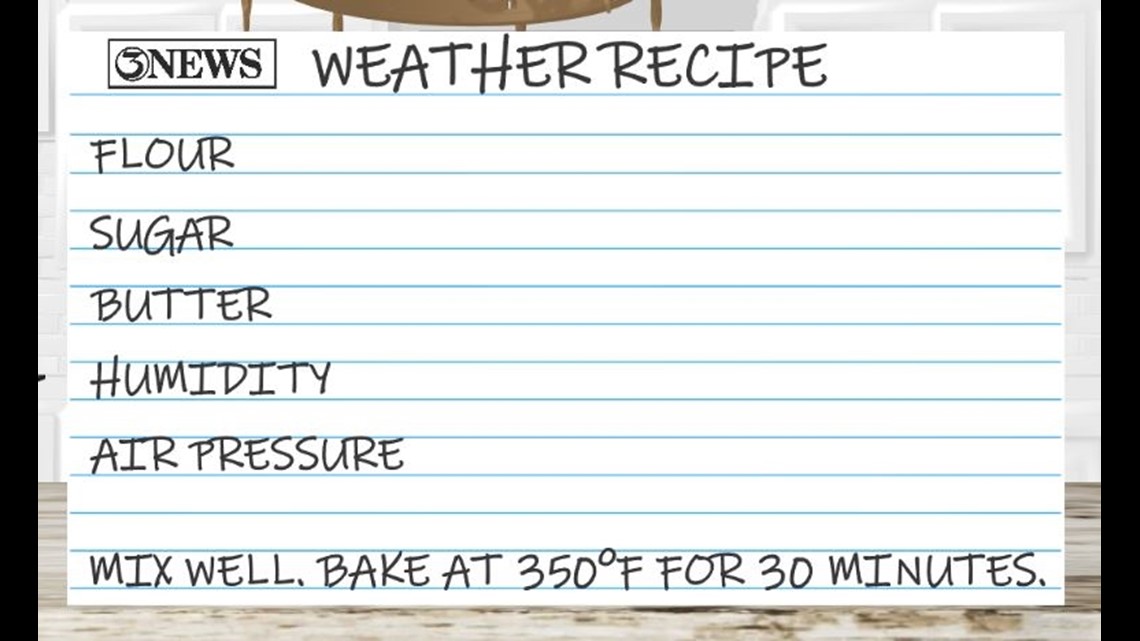WEATHER BLOG: How the weather affects cooking
Humidity can ruin everything from your hair to your mood – baking is no exception. Even air pressure can affect your baked goods. Here’s how.
Just in time for National Dessert Day on Friday, the humidity returns to Coastal Bend. Humidity can ruin everything from your hair to your mood – baking is no exception.
I remember an angel food cake my mom had baked was getting cold and it fell on the counter. She wasn’t too happy about that.
My mother, my grandmother and my aunts are all passionate bakers; I like to think I’m following in their footsteps. So when they say you can’t make divinity or peanut brittle and the dough rises differently when it’s wet, it’s worth listening to.
There is actually scientific truth in their claims. Humidity, temperature and even atmospheric pressure can affect the cooking process. Let’s start with humidity.
HUMIDITY
Humidity is by far the component of weather that has the most effect on cooking.
What we generally refer to when we talk about humidity is “relative humidity”. This relates the amount of moisture in the air to the amount that would be present if the air were saturated, which depends on the temperature of the air.
Warmer air can hold more moisture than cooler air, so bakers often run into problems on hot, humid or rainy days.
Humidity – especially indoor humidity – determines whether baked goods fall flat, are too dense, too dry, crumbly or rubbery. Cakes can get super crumbly on the surface and become harder to glaze when they cool on a rainy day.
Damp air ruins your dry baking ingredients. Ingredients like flour, sugar and baking powder are hygroscopic – that is, they absorb moisture from the surrounding air. This is how we end up with lumpy or cooked sugar and flour.
Many ingredients work best when stored in cool, dry areas. This also helps extend their shelf life. You can store dry ingredients in the refrigerator or freezer, but you must bring them to room temperature before using them. If you don’t, your doughs and batters may not rise properly.
It is also best to avoid meringues and divinity in heavy or humid weather. Sugar easily absorbs moisture from the air, which upsets the balance between egg white and sugar. The unbalanced ratio keeps the mixture too soft, prevents you from getting stiff peaks, and keeps it from hardening.
The ideal relative humidity for cooking is 40-60%, but some items require higher humidity. Dough fermentation requires a relative humidity of at least 75%. Thus, the dough generally rises faster in a humid house.
There may be too much of a “good thing”, though. A yeast dough that is too soft or too sticky is likely the result of hot, humid weather. Lower humidity generally results in crispier, crispier bread.
Even the humidity inside your oven can affect how your bread turns out – in many ways. If there is too much moisture, it obstructs heat transfer and makes your crust temperature too low, so you end up with a lighter colored crust. Higher humidity inside your oven can also help your baked goods retain moisture and also allows the yeast to continue to rise in the dough longer. It will also result in a shinier and thicker crust.
To combat high humidity, some websites suggest reducing the amount of liquid in your recipe by 1/4 cup; others suggest a 10-25% reduction.
TEMPERATURE
Some baked goods actually require heat before the oven. Bread dough is placed in a warm, humid place (like a proofer) because the yeast loves moisture and becomes more active, which causes the dough to rise faster. This also helps keep the dough moist.
Proofing is sometimes called the “second rise”. Dough proofing conditions are hot and humid: 95-110°F with 80-85% humidity. I will point out the obvious and say that most of us do not intentionally maintain these conditions in our homes.
AIR PRESSURE
Lower air pressure has two main effects on doughs and baked goods. First, they go up more easily. If an area of pressure (like a cold front) is nearby, baked goods will act as if they were being baked at a higher altitude where the atmospheric pressure is lower. Less air pressure essentially means less resistance, allowing cakes and breads to rise faster.
Second, they lose their moisture faster. Since water boils at lower temperatures at higher altitudes, liquids evaporate faster. At sea level, water boils and evaporates at 212°F. At 6,000 and 10,000 feet, water evaporates at 200°F and 194°F, respectively. This means your baked goods can dry faster during baking when low pressure is nearby.
So the next time you channel your inner Betty Crocker or Pillsbury Dough Boy, check the predictions first. It may just help you cook better.


Comments are closed.